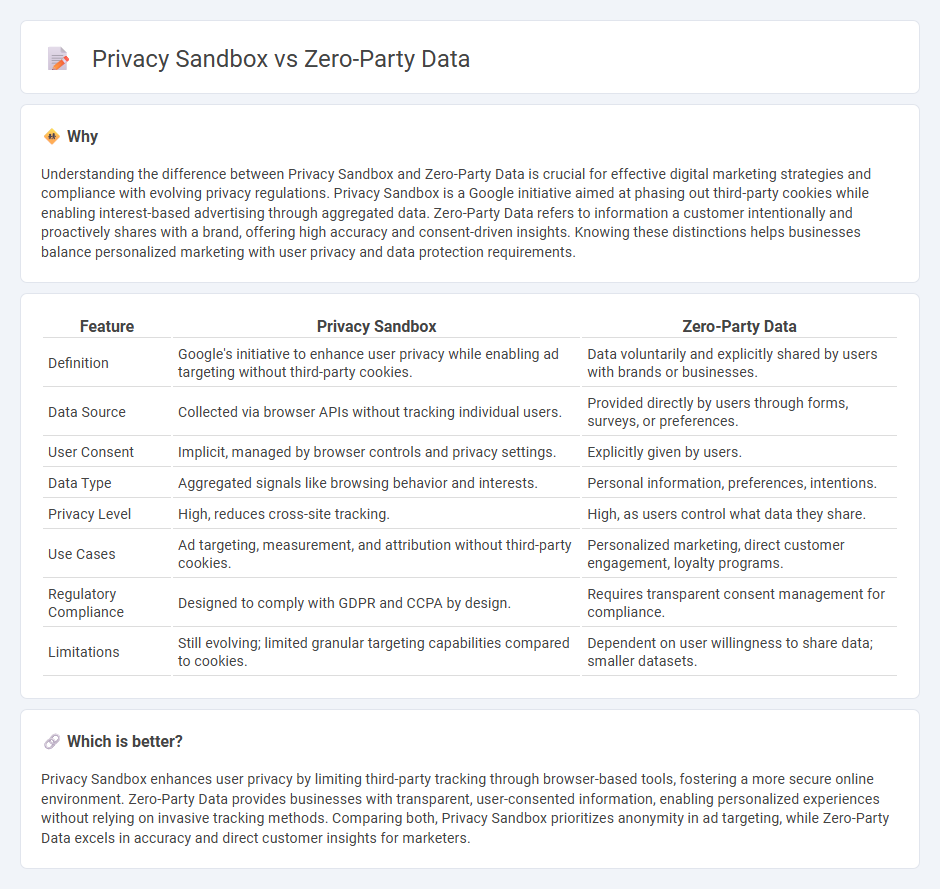
Privacy Sandbox offers a browser-based framework designed to replace third-party cookies with privacy-preserving APIs, enhancing user anonymity while enabling targeted advertising. Zero-Party Data refers to information that users proactively share with brands, such as preferences and intentions, allowing for highly personalized marketing without relying on tracking technologies. Discover how these emerging strategies are reshaping data privacy and digital advertising by exploring their core differences and benefits.
Why it is important
Understanding the difference between Privacy Sandbox and Zero-Party Data is crucial for effective digital marketing strategies and compliance with evolving privacy regulations. Privacy Sandbox is a Google initiative aimed at phasing out third-party cookies while enabling interest-based advertising through aggregated data. Zero-Party Data refers to information a customer intentionally and proactively shares with a brand, offering high accuracy and consent-driven insights. Knowing these distinctions helps businesses balance personalized marketing with user privacy and data protection requirements.
Comparison Table
| Feature | Privacy Sandbox | Zero-Party Data |
|---|---|---|
| Definition | Google's initiative to enhance user privacy while enabling ad targeting without third-party cookies. | Data voluntarily and explicitly shared by users with brands or businesses. |
| Data Source | Collected via browser APIs without tracking individual users. | Provided directly by users through forms, surveys, or preferences. |
| User Consent | Implicit, managed by browser controls and privacy settings. | Explicitly given by users. |
| Data Type | Aggregated signals like browsing behavior and interests. | Personal information, preferences, intentions. |
| Privacy Level | High, reduces cross-site tracking. | High, as users control what data they share. |
| Use Cases | Ad targeting, measurement, and attribution without third-party cookies. | Personalized marketing, direct customer engagement, loyalty programs. |
| Regulatory Compliance | Designed to comply with GDPR and CCPA by design. | Requires transparent consent management for compliance. |
| Limitations | Still evolving; limited granular targeting capabilities compared to cookies. | Dependent on user willingness to share data; smaller datasets. |
Which is better?
Privacy Sandbox enhances user privacy by limiting third-party tracking through browser-based tools, fostering a more secure online environment. Zero-Party Data provides businesses with transparent, user-consented information, enabling personalized experiences without relying on invasive tracking methods. Comparing both, Privacy Sandbox prioritizes anonymity in ad targeting, while Zero-Party Data excels in accuracy and direct customer insights for marketers.
Connection
Privacy Sandbox and Zero-Party Data are interconnected through their focus on enhancing user privacy while enabling targeted advertising. Privacy Sandbox, developed by Google, aims to replace third-party cookies with privacy-preserving APIs that limit data sharing, whereas Zero-Party Data refers to information that users intentionally share with brands, facilitating personalized experiences without compromising privacy. Together, they represent a shift toward transparent data practices that prioritize user consent and minimize reliance on intrusive tracking technologies.
Key Terms
User consent
Zero-party data, collected directly from users with explicit consent, offers brands transparent insights into customer preferences without compromising privacy. In contrast, Google's Privacy Sandbox aims to phase out third-party cookies, enhancing user privacy while enabling targeted advertising through aggregated, anonymized data. Explore how these approaches redefine user consent and data privacy in digital marketing.
Data transparency
Zero-party data empowers businesses with direct consumer insights voluntarily shared, enhancing data transparency by fostering trust and consent-driven interactions. Privacy Sandbox limits third-party cookie tracking, emphasizing privacy-preserving technologies for transparent data collection within browsers. Explore the evolving dynamics between zero-party data and Privacy Sandbox to understand how transparency reshapes user data privacy.
Third-party tracking
Zero-party data represents information that users voluntarily and proactively share with brands, providing high accuracy and trust without relying on external cookies. The Privacy Sandbox initiative by Google aims to phase out third-party cookies, promoting privacy-preserving technologies that limit covert tracking while enabling targeted advertising through aggregated data. Explore how these evolving concepts reshape digital marketing strategies and enhance user privacy in a post-cookie era.
Source and External Links
Zero-Party Data vs First-Party Data: Differences & Benefits - Zero-party data is information that customers intentionally and voluntarily share with a company, such as preferences collected via quizzes, polls, or feedback forms, and is used to personalize marketing and product offerings.
Zero-party data: definition, best practices and use cases - Zero-party data is hard-to-infer data that customers proactively provide, enabling brands to personalize content without being intrusive and to build stronger, more direct relationships with their audience.
The Importance of Zero-Party Data - Zero-party data involves customers intentionally sharing personal details with a business, and effective strategies rely on transparent communication, integration with first-party data, and omnichannel collection to enhance customer experiences.
 dowidth.com
dowidth.com